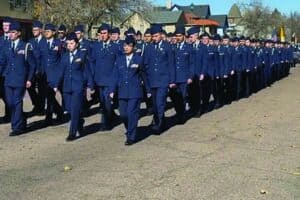Twisters along the eastern plains are not uncommon this time of year and knowing what to do could save your life.Jim Mesite, emergency program manager for the El Paso County Emergency Services Department, said El Paso County has the fifth largest number of tornados per year of any county in the state.Peak tornado season is typically now through July, he said, and most tornados occur between 3 p.m. and 9 p.m.A tornado in Ellicott May 31, 2001, was the last confirmed tornado in El Paso County, but, “There have been a couple of smaller ones since then, but they didn’t do much damage,” he said.Mesite said a sign of a potential tornado is the development of a wall-cloud. “It’s typically a nasty looking dark, often greenish, cloud with an edge to it between the ground and the cloud.” Winds that generate tornados rotate in a circular fashion, which is caused by a difference in air pressure, he said. Warm and cold weather fronts meet from tangent directions making conditions for a tornado possible.Senior Meteorologist Stephen Hodanish of the National Weather Service Pueblo station said about 50 tornados occur in Colorado each year. The weather phenomenon typically favors the plains, including El Paso County northeast toward Akron and Limon; Washington County, Lincoln County and near Denver International Airport.Tornado season usually lasts from May through October, Hodanish said, but can sometimes start as early as March.The best thing to do during poor weather is to be alert of the weather forecast. “Be aware of your environment. Don’t get caught off guard,” Hodanish said.The NWS will issue a tornado warning if it is very likely a tornado will develop because of current weather conditions or if one has already been sighted or detected on radar. A tornado watch, Mesite said, is issued when weather conditions are favorable for a tornado to develop.Hodanish said a weather radio is a good option for receiving continuous weather information from a nearby NWS office. When a warning is broadcast, the radio alarm activates. Other resources to receive weather information, he said, include the Internet, private companies that call residents on the telephone for a fee and the media.Three NWS offices in Colorado and one in Goodland, Kan., monitor the state weather. Pueblo serves the southeast plains and the southeast part of the state; Grand Junction covers the western slope; Denver serves northern Colorado; and Goodland serves the extreme east and northeast part of the state.If a tornado is near, get into a well-constructed building, a basement underneath something or go to the middle of a house, Hodanish said. “Get as many walls between you and the tornado as possible,” he said. “A tornado works its way from the roof to the exterior walls and then the interior walls.””In lieu of a basement, generally, interior rooms with a small space, such as a restroom or closet, are good,” Mesite said. He advised not to seek shelter in a gymnasium because winds pick up the roof and throw it back down.”Most people are hurt or killed by flying debris, not by being lifted up and thrown by a tornado,” he said.If driving during bad weather, Hodanish said, drive away and not into the storm. A tornado often cannot be seen because of other weather conditions.Mesite said do not try to outrun the tornado because it is often difficult to know which direction the tornado is traveling. He said if a tornado is near, stop the car and get into a sturdy building or lie in a depression in the ground, such as a drainage ditch.Always evacuate a mobile home because the structure cannot sustain winds, Hodanish said. Ask the mobile home community manager if a shelter is located within the community.To educate students, Joe Cole, School District 49 community relations coordinator, said all schools in the district conduct a drill each quarter during the school year. He said the program is facilitated through the El Paso County facilities department.”We want kids to be refreshed on tornado procedures,” Cole said. To ensure students know the drill, plans are in place in each classroom and module, with maps of evacuation routes.Mesite said the emergency services department handles all hazardous and large-scale emergencies and disasters in the county. Although the county does not have a warning system, several small municipalities have their own systems.He said if a tornado is seen, call 911. “That way, we can let everyone else know and try to protect the public. Even though there may be no immediate danger or death it has the potential of hurting people,” Mesite said.The emergency services department holds public affairs presentations for small groups, such as home-schooled kids, and larger groups, such as civic groups. “We speak to any group who wants to learn about any potential large-scale emergency, such as tornadoes, hazardous material incidents, wildfires and terrorist attacks,” Mesite said.






